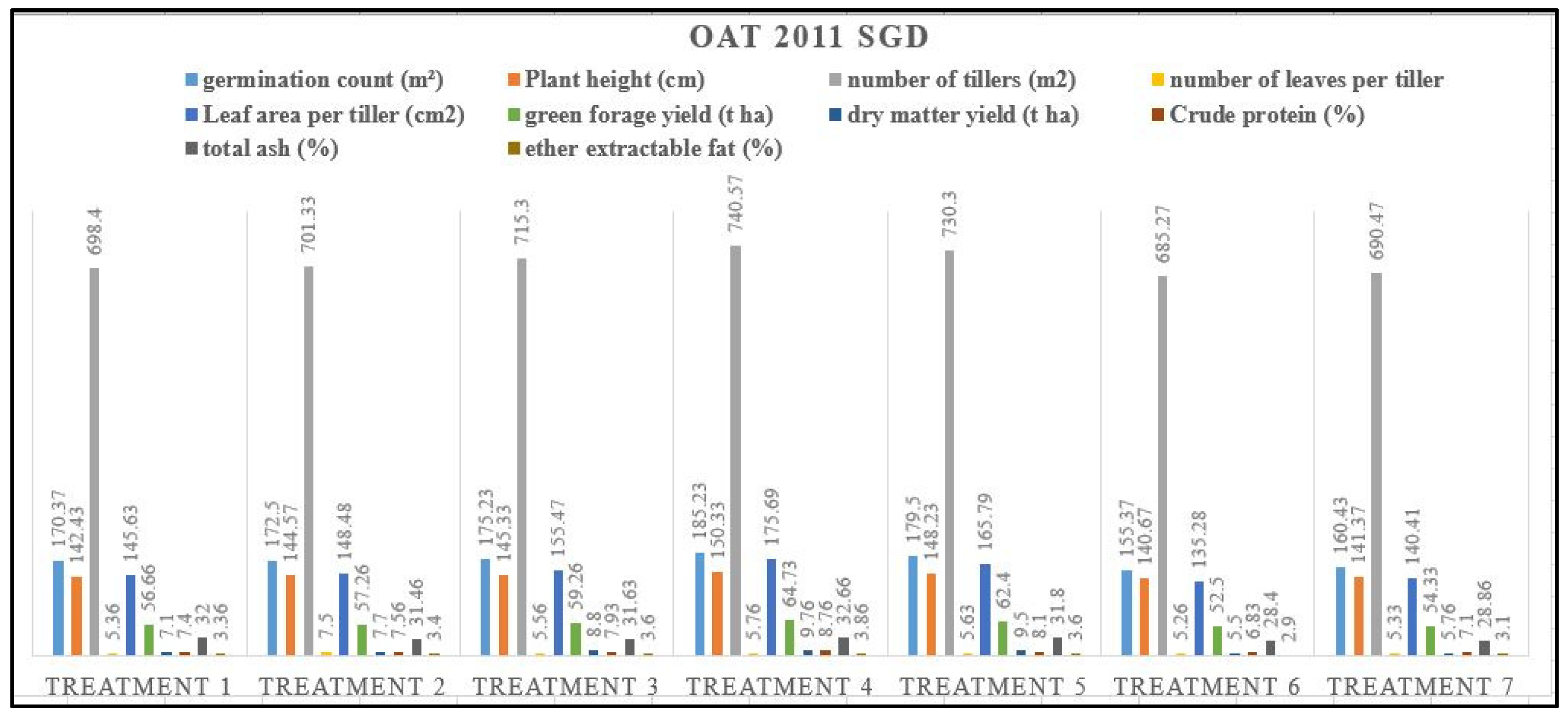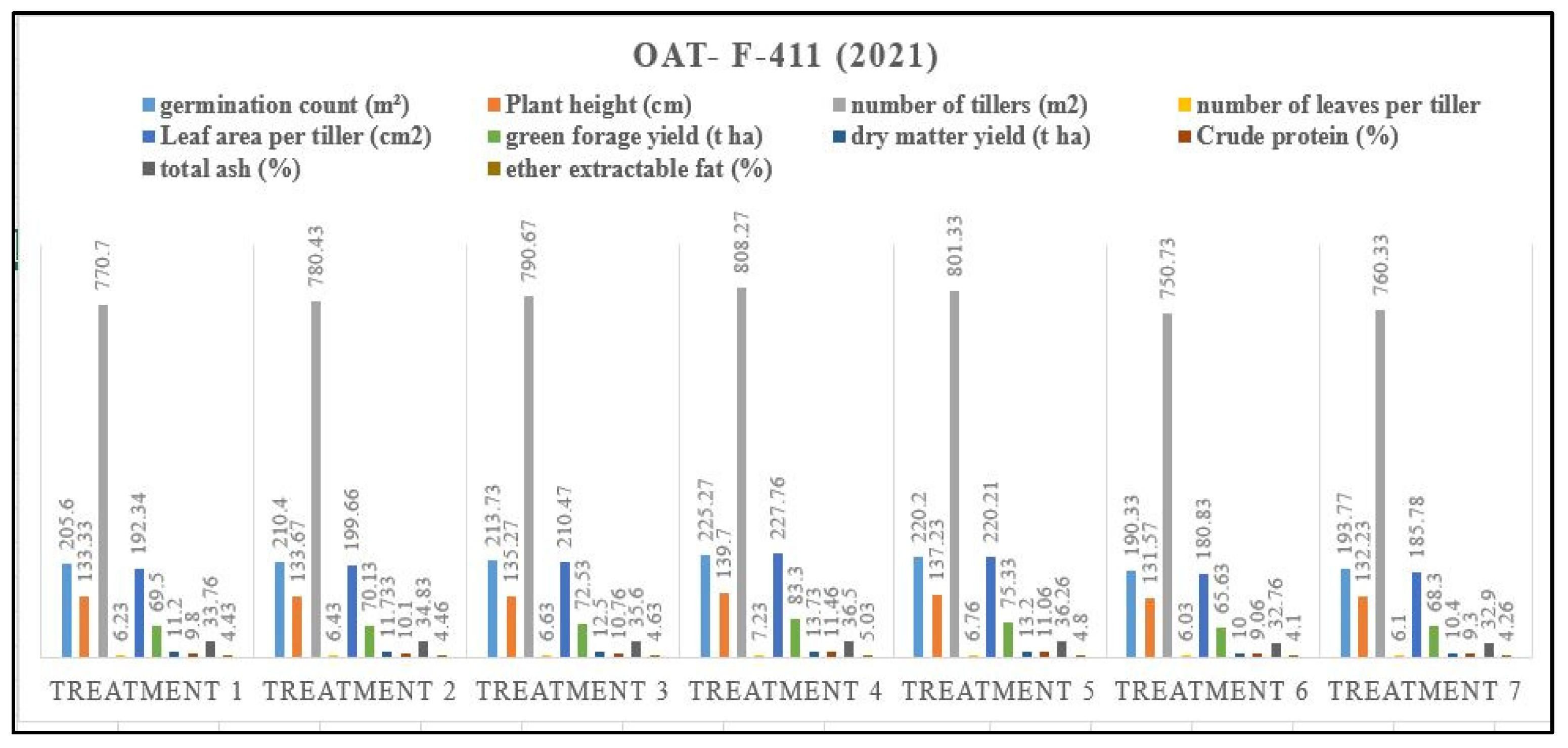Impact of Integrated Nutrient Management on Yield of Different Varieties of Oat †
Abstract
1. Introduction
2. Methodology
2.1. Soil Sample Analysis
2.2. Treatments: Factor A: Varieties
- V1: Oat-2011 (2011) SGD; V2: Oat-F-411 (2021) FSD
- Factor B: Integrated Nutrient Management (INM)
- T1: Recommended dose of fertilizer (RDF) N:P:K = 150:85:62 kg ha−1 (control)
- T2: RDF + 5 t ha−1 Farmyard Manure
- T3: RDF + 5 t ha−1 Poultry Manure
- T4: 50% RDF + 5 ton ha−1 Farmyard Manure + (seed inoculation with azotobacter)
- T5: 50% RDF + 5 ton ha−1 Poultry Manure + (seed inoculation with azotobacter)
- T6: 25% RDF + 5 ton ha−1 Farmyard Manure + (seed inoculation with azotobacter)
- T7: 25% RDF + 5 ton ha−1 Poultry Manure + (seed inoculation with azotobacter)
3. Results
Effect of (INM) on Oat Varieties with Different Treatments
4. Conclusions
Author Contributions
Funding
Institutional Review Board Statement
Informed Consent Statement
Data Availability Statement
Conflicts of Interest
References
- Azam, A.; Shafique, M. Agriculture in Pakistan and its Impact on Economy—A Review. Int. J. Adv. Sci. Technol. 2017, 103, 47–60. [Google Scholar] [CrossRef]
- Muhammed, D.; Serkan, A. In Intercropping of legumes with Cereal crops in particular with the Perennials, Perennial Crops for Food Security. In Proceedings of the FAO Expert Workshop, Rome, Italy, 28–30 August 2018; p. 221. [Google Scholar]
- uz Zaman, G.; Hussain, M.N.; Aziz, A. Performance of high yielding oat varieties under agro)-e cological conditions. J. Agric. Res. 2006, 44. [Google Scholar]
- Haqqani, A.; Ali, Z.; Shafique, S.; Zahid, S.; Bakhsh, A. Oats: A fodder of winter lean period. Agridigest 2003, 23, 15–23. [Google Scholar]
- Ghafoor, R.; Akram, N.A.; Rashid, M.; Ashraf, M.; Iqbal, M.; Lixin, Z. Exogenously applied proline induced changes in key anatomical features and physio-biochemical attributes in water stressed oat (Avena sativa L.) plants. Physiol. Mol. Biol. Plants 2019, 25, 1121–1135. [Google Scholar] [CrossRef] [PubMed]
- Dost, M. Fodder Success Story: Improved Fodder Crop Production in the Northern Areas of Pakistan; Food and Agriculture Organization: Rome, Italy, 2001. [Google Scholar]
- Mahato, M.; Biswas, S.; Dutta, D. Effect of Integrated Nutrient Management on Growth, Yield and Economics of Hybrid Maize (Zea mays L.). Curr. J. Appl. Sci. Technol. 2020, 39, 78–86. [Google Scholar] [CrossRef]
- Jehangir, W.A.; Qureshi, A.S.; Ali, N. Conjunctive Water Management in the Rechna Doab: An Overview of Resources and Issues; International Water Management Institute: Colombo, Sri Lanka, 2002. [Google Scholar]




Publisher’s Note: MDPI stays neutral with regard to jurisdictional claims in published maps and institutional affiliations. |
© 2022 by the authors. Licensee MDPI, Basel, Switzerland. This article is an open access article distributed under the terms and conditions of the Creative Commons Attribution (CC BY) license (https://creativecommons.org/licenses/by/4.0/).
Share and Cite
Anjum, L.; Rehman, A.; Rizwan, M.; Hussain, S.; Waqas, M.S. Impact of Integrated Nutrient Management on Yield of Different Varieties of Oat. Environ. Sci. Proc. 2022, 23, 14. https://doi.org/10.3390/environsciproc2022023014
Anjum L, Rehman A, Rizwan M, Hussain S, Waqas MS. Impact of Integrated Nutrient Management on Yield of Different Varieties of Oat. Environmental Sciences Proceedings. 2022; 23(1):14. https://doi.org/10.3390/environsciproc2022023014
Chicago/Turabian StyleAnjum, Lubna, Abdul Rehman, Muhammad Rizwan, Saddam Hussain, and Muhammad Sohail Waqas. 2022. "Impact of Integrated Nutrient Management on Yield of Different Varieties of Oat" Environmental Sciences Proceedings 23, no. 1: 14. https://doi.org/10.3390/environsciproc2022023014
APA StyleAnjum, L., Rehman, A., Rizwan, M., Hussain, S., & Waqas, M. S. (2022). Impact of Integrated Nutrient Management on Yield of Different Varieties of Oat. Environmental Sciences Proceedings, 23(1), 14. https://doi.org/10.3390/environsciproc2022023014







